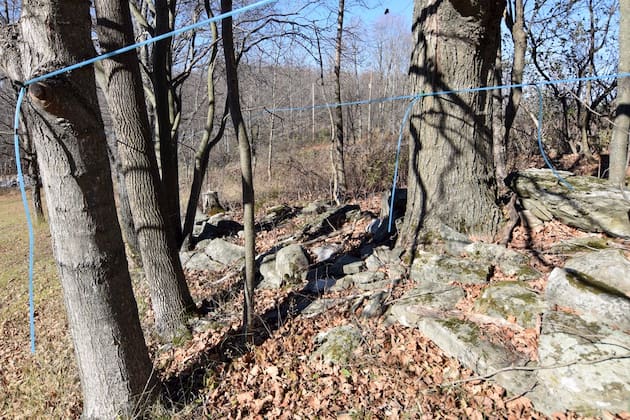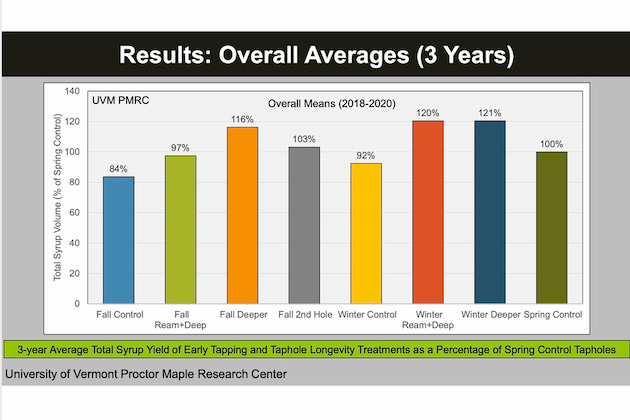UVM Proctor Page
Vermont researchers downplay fall tapping
'Don't bother,' says expert. Not worth extra aggravation and no extra sap
By PETER GREGG | NOVEMBER 10, 2020
UNDERHILL CTR., Vt.—Thinking about tapping this fall? Don’t bother.
That’s the message from Abby van den Berg, a research scientist at the Proctor Maple Research Center in Underhill Center, Vt. who hosted a compelling webinar on the topic last month.
“Generally speaking from a yield perspective, the data suggests fall tapping is not the best idea, especially factoring in all the extra things involved,” she said.
Dealing with extensive freeze and thaw cycles, tapping five feet in the air to account for winter snows in northern regions were just two of the big hassles that come with tapping extra early.
“Freezing and staying frozen is one of the challenges that you need to keep in mind,” she said.
She acknowledged that with climate change, there is temptation to try and capture early runs and mitigate quick-ending seasons. And early tapping is a necessity for big operations with tens of thousands of trees to drill.
But it’s the lack of payoff in extra sap that is probably the best reason to wait it out for traditional tapping in late winter and early spring.
van den Berg unveiled the preliminary results from a three-year study at Proctor on the yields and impacts of early tapping. It was a comprehensive project funded in part by Lapierre Equipment and the North American Maple Research Fund.
Proctor researchers tapped up to 80 trees in late October or early November from 2017-19 and then either “freshened” some holes by reaming with larger drill bits later in the fall or early winter, or reamed and drilled those original holes deeper to 2.5 inches deep in the middle of winter.
Researchers also left blocks just run continuously from October to April, unfreshened.
The results were fairly dramatic. None if it all that great.
“From a mathematical, statistical standpoint there were no differences between any of the treatments,” she said. “One of the reasons is that there was such a high amount of variation from tree to tree and year to year.”
Some autumns have a fairly good number of sap flow days and others there were very few days for sap flow, she said.
She questioned taking sugars from the tree in the middle of its dormant period.
“Were we taking sugar reserves away from the tree at a pretty critical point throughout the leafless period?” van den Berg said.
“The sugar is there to do important things for the tree. The sugar in the sap is the fuel for the tree to use to survive the winter when there are no leaves to create photosynthesis.”
The only treatment that showed a gain in yield was re-drilling fall taps deeper in the middle of winter. Some of those trees produced upwards of 20 percent extra sap for the duration.
But sugarmakers are warned to consider maybe the biggest drawback to early tapping and reaming or re-drilling deeper holes, and that is the creation of non-conductive wood.
Researchers cut out “cookies” of the early tapped trees to see what kind of staining all of the early tapping, reaming, re-drilling and double tapping was creating inside the tree.
A lot. Twice the amount of stain in some cases, van den Berg said. Leaving less tappable wood for seasons to come.
“If you are increasing non-conducive wood to get a small gain of sap, you are biting yourself in the butt for future yields with the addition of the non-conducive wood,” van den Berg said.
Bottom line?
“Straight fall tapping is not worthwhile to get extra sap, especially for all of the pain in the butt extra stuff you have to do,” she said. “Even when reaming deeper in the middle of winter, you’re not getting more sap than spring tapholes and you have all that extra work.”
She made exceptions for sugarmakers in other regions of the country, saying Ohio and Pennsylvania sugarmakers should be out in the middle of December since their seasons start and end earlier than in Northern Vermont where the study was done.
Sugarmaker Anthony Larson of Lake Russel Maple LLC in Newfoundland, Pa. chimed in on the webinar call and said his operation was gung ho on fall tapping this year. He will be tapping all 24,000 of his taps in the coming months.
“We had huge success last year,” Larson said. “We made syrup every month. It was crazy."
van den Berg said a detailed report on the entire study will be published in the near future.

































